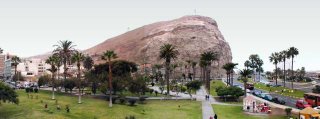Arica, population 160,000, is a border town at the intersection of Peru, Chile, Bolivia, and the Pacific. It has always been a center of trade. In pre-Columbian times, this was the southern terminus of Andean trade routes. When the Spanish dominated South America, Potosi silver streamed onto galleons here. Until the 1880s, Arica belonged to Peru. But with the War of the Pacific, Chile wrested control of the area from Peru and Bolivia. Now, it sits about 30 km south of the Chile-Peru border. With the status of a free trade zone, trade and commerce continue to dominate.
 The most obvious and imposing landmark is El Morro de Arica. The city sits at the large hunk of rock's foot. A major battle during the War of the Pacific was fought on the rock. From atop, a commanding view of the desert and ocean can be appreciated.
The most obvious and imposing landmark is El Morro de Arica. The city sits at the large hunk of rock's foot. A major battle during the War of the Pacific was fought on the rock. From atop, a commanding view of the desert and ocean can be appreciated.Arica is popular among rich Bolivianos because of its beaches. For fans of the architectural obscure, two of Alexandre Gustave Eiffel's works can be explored. The first is the Aduana de Arica, a customs house built in 1874. The other is Iglesia San Marcos, built in 1875.
The region is extremely dry. Some weather stations in the Atacama have never recorded any measureable rainfall. In Arica, the average rainfall is 0.03 inch per year. The city averages two to three inches of rain, total, every century!
The extremely arid condition explains why mummified remains have survived intact for so long. At the nearby Museo Arqueologico de San Miguel de Azapa, Chinchorro mummies are on display. These mummies, some of which are 7,000 years old, are the oldest in the world. Mummification was not relegated to the rich and powerful-- everyone was mummified at death.
The Parque Nacional Lauca cannot be missed. At least several days should be spent exploring the park, not only because there is so much to enjoy and cherish, but because it takes a while to acclimate to the altitude. Vicunas abound under the rich azure sky, with tall snowy peaks in the background. The jewel of the park is Lago Chungara, one of the highest lakes in the world at 4500 meters above sea level.
 CKY
CKY









No comments:
Post a Comment